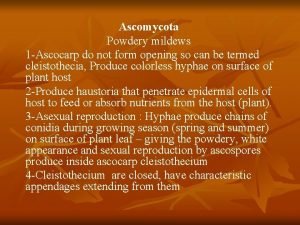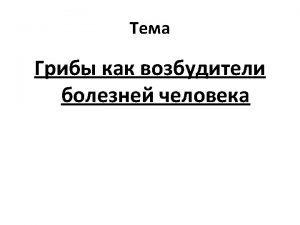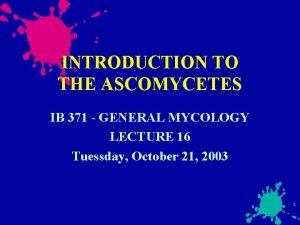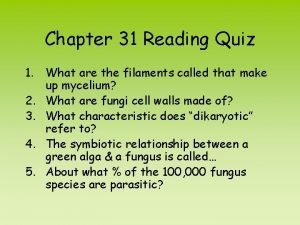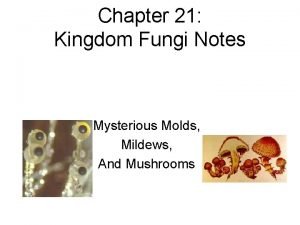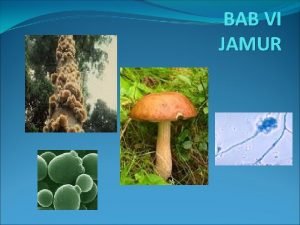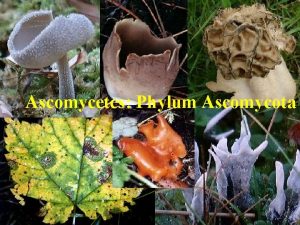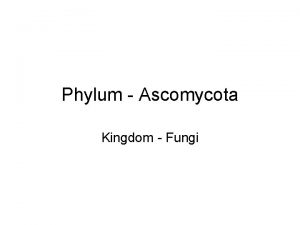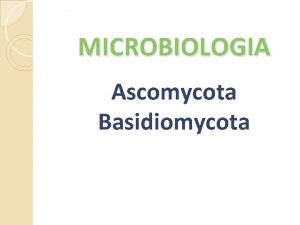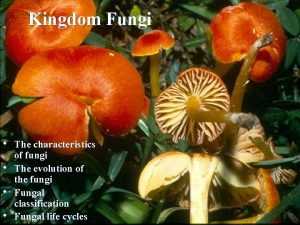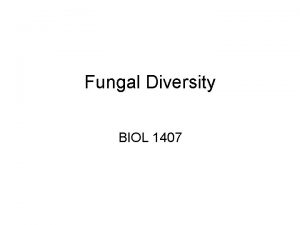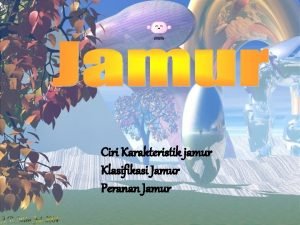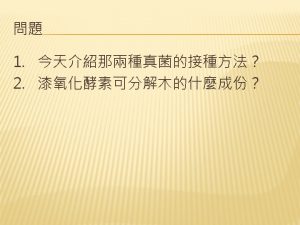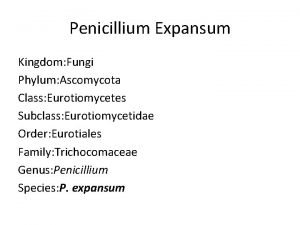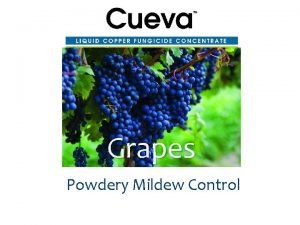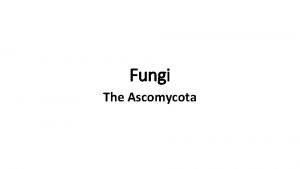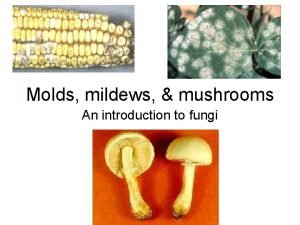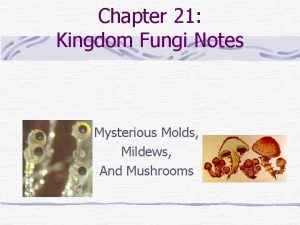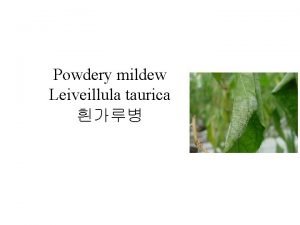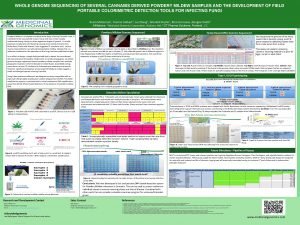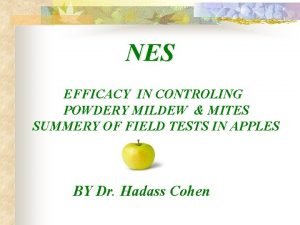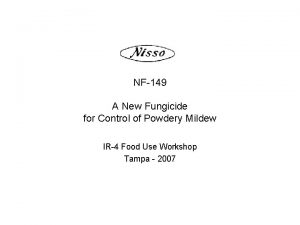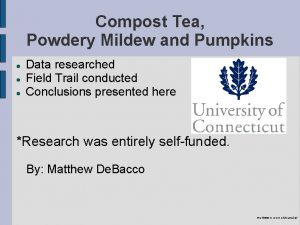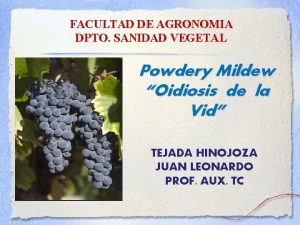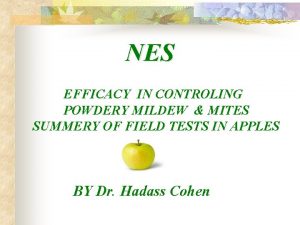Ascomycota Powdery mildews 1 Ascocarp do not form




















- Slides: 20

Ascomycota Powdery mildews 1 -Ascocarp do not form opening so can be termed cleistothecia, Produce colorless hyphae on surface of plant host 2 -Produce haustoria that penetrate epidermal cells of host to feed or absorb nutrients from the host (plant). 3 -Asexual reproduction : Hyphae produce chains of conidia during growing season (spring and summer) on surface of plant leaf – giving the powdery, white appearance and sexual reproduction by ascospores produce inside ascocarp cleistothecium 4 -Cleistothecium are closed, have characteristic appendages extending from them

n n n Truffles produce hypogeous ascocarp Ascocarp broken open by animals or by weathering Some species emit strong odor so that small animals, insects can detect them underground, dig up and eat them, dispersing spores Geopora, Tuber


n n n n n Yeasts Many species associated with flowers, fruits where high concentrations of sugar are present Many are facultative anaerobes – aerobic respiration or ethanol fermentation Widely used in brewing (beer, wine) and baking industries Some used as human & animal food, source of vitamins Also include some human pathogens – Candida albicans – normal flora Thallus is typically unicellular, in some species form Pseudomycelium ( Series of cells adhering after budding). Asexual reproduction – budding and fission and sexual reproduction by forming ascospore Commonly occurs as budding – unequal cell division where a daughter cell grows larger until it separates from mother cell

n n Phylum : Basidiomycota is one of two large phyla that, together with the Ascomycota, constitute the subkingdom Dikarya (often referred to as the "higher fungi") within the kingdom Fungi. its name comes from producing basidiospore. It is often referred to as " club fungi", all members of this Phylum form spores on club-shaped cells known as basidia. Mushrooms are the most common examples of the members

n n Characteristic of Basidiomycota : 1 -Basidiomycota are filamentous fungi composed of septated hyphae (except for yeasts) are unicellular. 2 -Heterotrophic saprobes – cells of hyphae secrete digestive enzymes and absorb products of digestion 3 -include these groups: mushrooms, puffballs, stinkhorns, bracket fungi, earth stars others cause diseases for human like yeast Cryptococcus and parasite on plants , rusts disease , smuts disease many species eaten are poisonous or semi-poisonous species.

Fig. 31 -18 Maiden veil fungus (Dictyphora), a fungus with an odor like rotting meat Puffballs emitting spores Shelf fungi, important decomposers of wood


n n n 4 - The cell walls of the hyphae are variably composed of chitin and β-glucans. 5 - Almost all its individuals are terrestrial , parasitic or saprophytic 6 - The sexual spores produced are basidiospores that are typically borne, exogenously, on horn-like sterigmata (sing. =sterigma) of basidia (sing. = basidium) each basidium bear four basidiospores

Unicellular basidium, with four sterigmata and basidiospores. 7 -reproducing A sexually by budding , fragmentation of hyphae to form Arthrospores(arthrospore. A spore resulting from the fragmentation of a hypha, as in the conidial stage of many Basidiomycota. ) , conidia , urediospores

Basidiospore and basidium Basidiospore is sexual reproduction unit have a single haploid nucleus (1 n) that is the product of meiosis, and they are produced by specialized fungal cells called basidia ( sexual structure , swollen at the top and carries on its surface four sterigmta each stergima bear one basidiospore therefore basidiomycota also is called club fungi. there are many types of basidia . . Holobasidium : Most basidiomycetes have single celled basidia ( consists from one cell non sepatate in different shapes. Phragmobasidium A basidium multicellular that is divided into more than one cell by transverse or longitudinal septa.


n basidiocarp, also called basidioma, in fungi, a large sporophore, or fruiting body, in which sexually produced spores are formed on the surface of club-shaped structures (basidia). Basidiocarps are found among the members of the phylum Basidiomycota, with the exception of the rust and smut fungi. There are many types of basidiocarp mushroom , jelly fungi , mushrooms, puffballs, stinkhorns, bracket fungi, earth stars and others.

n n n n Sexual Sporulation in the Basidiomycota Formation of basidiospores: Two HAPLOID NUCLEI in an apical dikaryotic hyphal compartment (often within a basidiocarp) FUSE to form a DIPLOID NUCLEUS. The DIPLOID NUCLEUS undergoes MEIOSIS to produce four haploid nuclei. Four small outgrowths - STERIGMATA - begin to form at the top of the hyphal compartment and the tip of each sterigma begins to inflate. The uninucleate swelling at the tip of each sterigma matures into a BASIDIOSPORE. The compartment supporting the sterigmata and basidiospores is called a BASIDIUM.


n n n n n Classification of fungi belonging to the Basidiomycota is based upon the presence or absence of fruiting bodies (BASIDIOCARPS) and the type of basidiocarp formed. . Classification of fungi belonging to the Basidiomycota: 1. Teliomycetes basidiocarp (fruiting body) absent. The rust and smut fungi are two important of plant pathogenic fungi belonging to the Teliomycetes. 2. Hymenomycetes The largest class in the Basidiomycota. The basidia are arranged in a layer known as a HYMENIUM that is fully exposed at maturity. Basidiocarp is present (mushroom)

n n Agaricus spp. (mushroom) is a genus of mushrooms containing both edible and poisonous species, with possibly over 300 members worldwide. basidiocarp like umbrella shaped consist from the following parts: 1 -Pileus (cap) 4 - stipe(stalk) 2 -Gills( lamellae) 3 -Annulus (ring)


n n 3. Gasteromycetes Includes fungi known as PUFF-BALLS, EARTH-STARS and BIRDS' NEST FUNGI. The spore-producing hymenium is NOT EXPOSED at maturity. But these fungi have evolved a variety of mechanisms to ensure efficient spore liberation.

n n n n Deutromycota The division Deuteromycota is also called the Fungi Imperfecti or Imperfect Fungi referring to our "imperfect" knowledge of their complete life cycles. The Deuteromycota are characterized by 1 - production of septate mycelium and/or yeasts, 2 - sexual life cycle that is either unknown or absent. 3 -Asexual reproduction is by means of conidia (sing. =conidium) 4 -Where sexual reproduction has been determined for species in this taxon, the sexual stage is usually referrable to the Ascomycota or Basidiomycota. 5 - when both sexual and asexual stages are known to occur in a life cycle, they are referred to as telomorph and anamorph, respectively. There a number of different classification schemes for this group of fungi. However, keep in mind that since we are not working with sexual stages here that the classification schemes used to classify the Deuteromycota is artificial and is not intended to show relationship between the taxa. We will recognize a single class: Deuteromycetes
 Dictyphora
Dictyphora Powdery mildew rosemary
Powdery mildew rosemary English 9 vocabulary unit 1
English 9 vocabulary unit 1 Hortae
Hortae Ascomycota asexual reproduction
Ascomycota asexual reproduction Ascomycota asexual reproduction
Ascomycota asexual reproduction Fungi examples
Fungi examples Struktur tubuh ascomycota
Struktur tubuh ascomycota Hymenium ascomycota
Hymenium ascomycota Crozier formation in fungi
Crozier formation in fungi Zygomycota ascomycota basidiomycota
Zygomycota ascomycota basidiomycota Fungi phylum
Fungi phylum Fungi characteristics
Fungi characteristics Tom volk
Tom volk Peranan jamur ascomycota
Peranan jamur ascomycota Paraphsis
Paraphsis Ascomycota basidiomycota zygomycota chytridiomycota
Ascomycota basidiomycota zygomycota chytridiomycota Ascomycota kingdom
Ascomycota kingdom Is yeast a heterotroph or autotroph
Is yeast a heterotroph or autotroph Chytridiomycota
Chytridiomycota Ascomycot
Ascomycot
